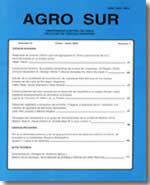Frequency of hydric reposition in olives (Olea europaea L.) under drip irrigation in a clay loam soil
Main Article Content
Abstract
A field experiment was carried out in the 2002-2003 growing season in order to determine the effect of irrigation frequency on the vegetative growth of two year old olives (Olea europaea L.), cv. Arbequina, under drip irrigation in a clay loam soil. The study was undertaken at the Agricultural Experimental Station of the University of Concepción, in Chillán, Chile (36°34’ S lat, 72°06 W long). The treatments of irrigation frequencies were T1, once daily; T2, once every 4 days; and T3, once every 7 days. The following soil and vegetative parameters were determined volumetric soil water content, trunk diameter, plant height, leaf area, shoot length, dry matter and diffusive resistance. The results showed that in clay loam soils, low irrigation frequency did not provoke statistically significant differences in the vegetative behaviour, except in the plant height and leaf area where a greater growth was observed with T1 and T2, respectively. Low irrigation frequencies increased the wet bulb size and the root growth that will provoke accumulative effects on the vegetative behaviour in the following season. On the other hand, a high irrigation frequency produced a superficial water concentration and a declining of diffusive resistance.

